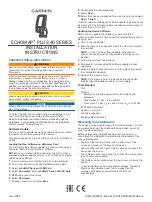
2
If necessary, extend the wires using 0.82 mm
2
(18 AWG) or
larger wire.
3
Connect the red wire to the positive terminal on the battery or
fuse block, and connect the black wire to the negative
terminal.
Wiring Harness
• The wiring harness is used for NMEA
®
0183 devices, and to
share route and waypoint information.
• The wiring harness connects the device to power and NMEA
0183 devices.
• The device has one internal NMEA 0183 port that is used to
connect to NMEA 0183 compliant devices.
• If it is necessary to extend the power and ground wires, you
must use 0.82 mm
2
(18 AWG) or larger wire.
• If it is necessary to extend the NMEA 0183 or alarm wires,
you must use .33 mm
2
(22 AWG) wire.
Item
Wire Function
Wire Color
NMEA 0183 internal port Rx (in)
Brown
NMEA 0183 internal port Tx (out)
Blue
Ground (power and NMEA 0183)
Black
Power
Red
NMEA 0183 Connection Considerations
• The installation instructions provided with your NMEA 0183
compatible device should contain the information you need to
identify the transmitting (Tx) and receiving (Rx) A (+) and B
(-) wires. Each port may have one or two transmitting wires,
or one or two receiving wires.
• When connecting NMEA 0183 devices to ports containing
two transmitting (Tx) wires or two receiving (Rx) wires each, it
is not necessary for the NMEA 0183 device to connect to a
common ground.
• When connecting a NMEA 0183 device to ports containing
one transmitting (Tx) wire or one receiving (Rx) wire each,
the NMEA 0183 device must be connected to a common
ground.
• When the device is mounted in a location that prevents the
internal antenna from acquiring a satellite signal, you can
connect an external GPS 19x antenna through a NMEA 0183
connection. For more information, see the
GPS 19x
Installation Instructions
.
NMEA 0183 Connection Diagram
+
-
Item
Description
12 Vdc power source
Wiring harness
NMEA 0183 compliant device
Item Garmin Wire
Function
Garmin Wire
Color
NMEA 0183 Device Wire
Function
Power
Red
Power
Ground
Black
Data ground
Tx/Rx
Tx/Rx/B (-)
Tx
Blue
Rx/A (+)
Rx
Brown
Tx/A (+)
Connecting to a Garmin Device to Share User Data
You can connect the ECHOMAP Plus device to a compatible
Garmin device to share user data, such as waypoints. If the
devices are mounted near each other, you can connect the blue
and brown wires. If the devices are mounted too far apart for the
wires to reach, you can connect the devices using a User Data
Sharing Cable (010-12234-06).
1
Make sure both devices are connected to the same ground.
2
Complete an action:
• If the devices are mounted near each other, connect the
blue wire from the first device to the brown wire of the
second, and connect the brown wire from the first device
to the blue wire of the second.
• If the devices are not mounted near each other, obtain a
User Data Sharing Cable (010-12234-06), and connect
the devices following the instructions included with the
cable.
3
On both devices, select
Navigation Info
>
Manage Data
>
User Data Sharing
.
User data is shared between the connected devices. If you
select Clear User Data, data is removed from both connected
devices.
Connecting the Device to a Transducer
or contact your local
Garmin dealer to determine the appropriate type of transducer
for your needs.
1
Follow the instructions provided with your transducer to
correctly install it on your boat.
2
Route the transducer cable to the back of your device, away
from sources of electrical interference.
3
Connect the transducer cable to the appropriate port on the
cradle.
Connecting the Cables to the Cradle
The connectors on the cables are keyed to fit in only in the
correct ports on the cradle. The connected cables are held in
place by a locking bracket.
1
Slide the cable locking bracket up from the bottom and
remove the bracket from the cradle.
2
Compare the divots on each cable connector to the keying
on each port to determine which cable corresponds to each
port.
3
Fully and firmly insert each cable through a hole in the cradle,
and securely connect each cable to a port.
3
























